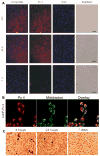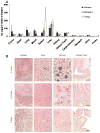Deep penetration of a PDT drug into tumors by noncovalent drug-gold nanoparticle conjugates
- PMID: 21294543
- PMCID: PMC3056176
- DOI: 10.1021/ja108846h
Deep penetration of a PDT drug into tumors by noncovalent drug-gold nanoparticle conjugates
Abstract
Efficient drug delivery to tumors is of ever-increasing importance. Single-visit diagnosis and treatment sessions are the goal of future theranostics. In this work, a noncovalent PDT cancer drug-gold nanoparticle (Au NP) conjugate system performed a rapid drug release and deep penetration of the drug into tumors within hours. The drug delivery mechanism of the PDT drug through Au NPs into tumors by passive accumulation was investigated via fluorescence imaging, elemental analysis, and histological staining. The pharmacokinetics of the conjugates over a 7-day test period showed rapid drug excretion, as monitored via the fluorescence of the drug in urine. Moreover, the biodistribution of Au NPs in this study period indicated clearance of the NPs from the mice. This study suggests that noncovalent delivery via Au NPs provides an attractive approach for cancer drugs to penetrate deep into the center of tumors.
Figures






References
Publication types
MeSH terms
Substances
Grants and funding
LinkOut - more resources
Full Text Sources
Other Literature Sources
Miscellaneous

